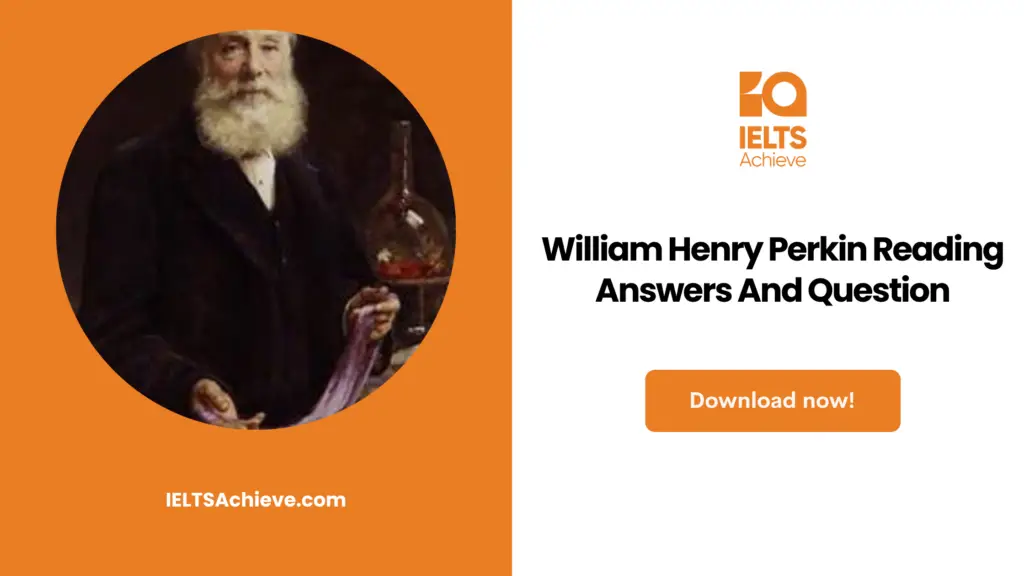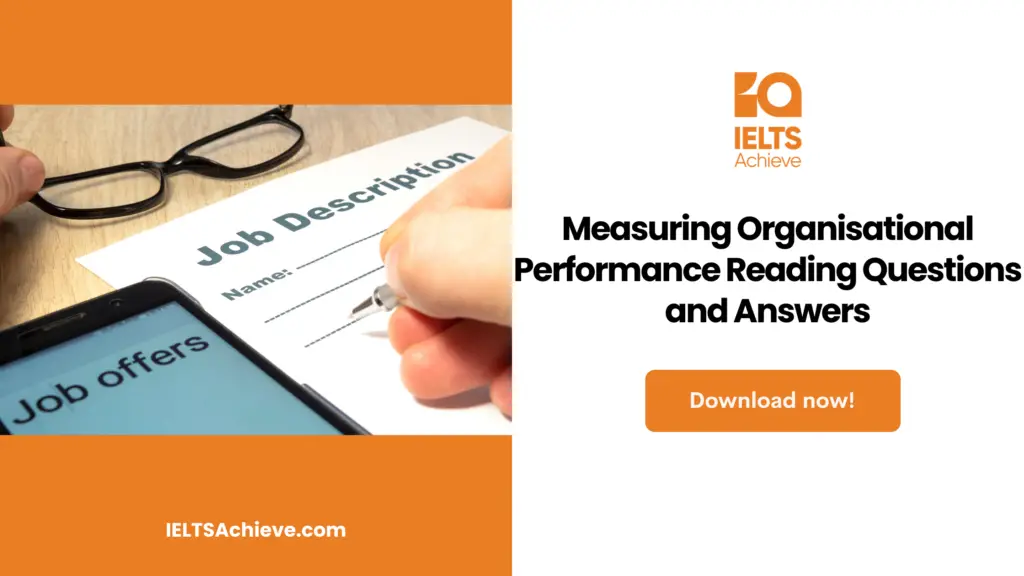The Blog post contains the following IELTS Reading Questions:
- IELTS Reading Short Answer Questions
- IELTS Reading Multiple Choice Questions
- IELTS Reading Flowchart Completion
Stay informed and prepared for success – Explore our comprehensive Reading Test Info page to get valuable insights, exam format details, and expert tips for mastering the IELTS Reading section.
IELTS reading passage – William Henry Perkin

William Henry Perkin
On 12 March 1838, William Henry Perkin was born in London, England.
Curiosity drives the early Perkins to the arts, sciences, photography and engineering till he gets into the laboratory of his late grandfather. It developed his enthusiasm towards chemistry.
As a student at the City of London School, Perkin was wholly involved in the study of chemistry. Perkins’ talent and devotion to the subject of chemistry is recognized by his teacher. He attended Michal Faraday’s lectures at the Royal Institution by the encouragement of Thomas Hall. His speeches developed his interest towards chemistry further. Later, at the age of 15, 1853, Perkin attended the Royal College of Chemistry.
German chemist August Wilhelm Hofmann was head at the Royal college of chemistry during the time of Perkin’s enrolment. Hofmann identified the perkin’s scientific gifts and he became a youngest assistant of Hofmann. After some time, Perkin got his fame and both through his scientific breakthrough.
Quinine is the only feasible medical treatment for malaria at that time. The drug is extracted from the cinchona tree’s bark, which is situated in South America. The demand for the drug increased by 1856. Hofmann made some comments about the synthetic substitute for quinine and his star pupil takes up as a challenge.
In 1856, during his vacation, he was trying to manufacture quinine from aniline (inexpensive and readily available coal tar waste) in his laboratory at the top of his family’s house. Out of his best efforts, he didn’t get the quinine, but some mysterious dark sludge. Fortunately, Perkin’s scientific training and nature made him explore the substance further. At the various stages of the experimental process, he added the potassium dichromate and alcohol into the aniline which produced a deep purple solution. Louis Pasteur’s words ‘chance favours only the prepared mind’, proved to be true, he saw the unexpected potential of his find.
Usually, the textile dye was made from natural resources such as plants and animal excretions. Few of these, like glandular mucus of snails, were both expensive and difficult to get. At that time, the rich can only afford the purple colour which is extracted from the snail as this is so costly. Moreover, the tendency of the natural dyes is found to be muddy in hue and fade quickly. Perkin’s discovery was against this backdrop.
Perkin understood that his purple solution could be used for colour fabric, which is the world’s first synthetic dye. He patented it as he realised the importance of his finding. One of the fascinating reactions of Perkin quickly found that the new dye has commercial possibilities.
Originally, Perkin named his dye Tyrian Purple. Later, it became commonly known as mauve. By asking advice to the Scottish dye works owner Robert Pullar, he understood that the dye manufacturing would be worthwhile if the colour remained fast (i.e. would not fade) and if it is relatively low cost. His mentor Hofmann objected to him in a fierce manner, so he left the college and gave birth to the modern chemical industry. Perkin set up a factory, near London, with the help of his father and brother. Coal tar is cheap and plentiful as this is an almost limitless by-product of London’s street lighting. The dye works started producing the world’s first synthetically dyed material in 1857. The Empress Eugenie of France, boosted the commercial part of the company as the new colour flattered her. Mauve becomes a necessary shade for all the fashionable ladies in that country.
In public, England’s Queen Victoria appears wearing a mauve gown which brought rage in England. The dye was both fast and bold, and the public demand was increased. Perkin returns to the drawing board.
Though Perkin’s first discovery itself brought him fortune and achievements, the chemist continued his research. He developed and introduced several other dyes including aniline red (1859) and aniline black (1863) and Perkin’s green in the late 1860s. Perkin’s synthetic dye discoveries resulted in more than just decorative purposes. The dyes also become important to medical research in many ways. For example, researchers are able to identify such bacilli as tuberculosis, cholera and anthrax, which were the invisible microbes and bacteria before. Artificial dyes continue to play an important role even today. Its current use in the search for a vaccine against malaria, which could have pleased the Perkin.
Unlock your full potential in the IELTS Reading section – Visit our IELTS Reading Practice Question Answer page now!
Recommended Questions:
Renewable Energy IELTS Reading Question with Answer
William Henry Perkin Reading Questions
Read the following questions carefully and write the William henry perkin reading answers. You will find william henry perkin reading answers with explanation at the end of the practice test.
Questions 1 – 5
Complete the flowchart below.
Choose NO MORE THAN TWO WORDS from the passage for each answer.

Boost your performance in Summary, Notes, Table, and Flowchart Completion tasks. Click here to explore our detailed guide and learn how to effectively complete summaries, notes, tables, and flowcharts in the IELTS Reading section.
Questions 6 – 10
Choose the correct letter, a, b, c or d, as you answer each question.
6. Whose lectures Perkin attended at the Royal Institution ?
- August Wilhelm Hofmann
- Thomas Hall
- Michal Faraday
- Niels Bohr
7. What is the age when Perkin attended the Royal College of Chemistry ?
- 15
- 18
- 20
- 14
8. Where is the quinine extracted from ?
- Tree’s bark
- Herbs
- Cinchona tree’s bark
- Dye
9. How the Tyrian Purple became commonly known as ?
- Purple
- Perkin’s Purple
- Aniline
- Mauve
10. Where did Perkin set up a factory ?
- London
- Bristol
- Leicester
- Norwich
Ready to improve your performance in Multiple Choice Questions (MCQs)? Click here to access our comprehensive guide on how to tackle MCQs effectively in the IELTS Reading section.
Questions 11 – 14
Answer the questions below.
Write THREE WORD AND/OR A NUMBER from the passage for each answer.
11.Which subject that Perkin is interested in ?
12.When the quinine drug demand increased ?
13.Who was head at the Royal College of Chemist when Perkin enrolled ?
14.Who appeared in the public wearing a mauve gown which brought rage in England ?
Unlock your full potential in the IELTS Reading section – Visit our IELTS Reading Practice Question Answer page now!
Recommended Questions:
Renewable Energy IELTS Reading Question with Answer
William Henry Perkin Reading Answers
1. Answer: London
2. Answer: Chemistry
3. Answer: Purple
4. Answer: Tyrian Purple
5. Answer: Green
6. Answer: c. Michal Faraday
7. Answer: a. 15
8. Answer: c. Cinchona Tree’s bark
9. Answer: d. Mauve
10. Answer: a. London
11. Answer: Chemistry
12. Answer: 1856
13. Answer: August Wilhelm Hofmann
14. Answer: England’s Queen Victoria

We hope you found this post useful in helping you to study for the IELTS Test. If you have any questions please let us know in the comments below or on the Facebook page.
The best way to keep up to date with posts like this is to like us on Facebook, then follow us on Instagram and Pinterest. If you need help preparing for the IELTS Test, join the IELTS Achieve Academy and see how we can assist you to achieve your desired band score. We offer an essay correction service, mock exams and online courses.

